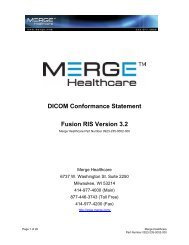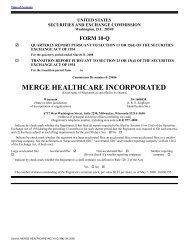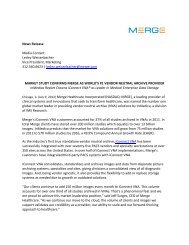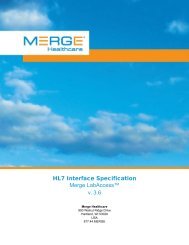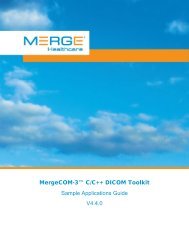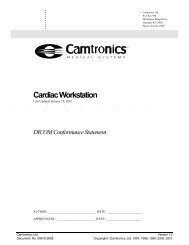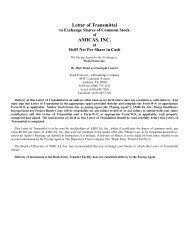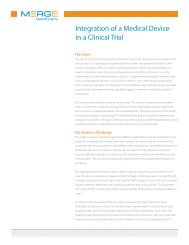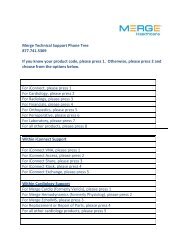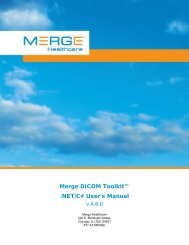There Has to Be More: iConnect - Merge Healthcare
There Has to Be More: iConnect - Merge Healthcare
There Has to Be More: iConnect - Merge Healthcare
You also want an ePaper? Increase the reach of your titles
YUMPU automatically turns print PDFs into web optimized ePapers that Google loves.
<strong>There</strong> <strong>Has</strong> <strong>to</strong> <strong>Be</strong> <strong>More</strong>:<br />
<strong>iConnect</strong>® Blends XDS and Image Exchange<br />
A <strong>Merge</strong> <strong>Healthcare</strong> Whitepaper
The Challenge<br />
You wouldn’t buy a new home without seeing it. A<br />
mechanic wouldn’t troubleshoot your car without<br />
first looking it over. A lawyer wouldn’t sign a legal<br />
contract without first reviewing it. Then why do<br />
we allow EMR and EHR systems <strong>to</strong> only exchange<br />
partial patient information without providing a<br />
complete picture of the patient?<br />
In 2010, an estimated five billion medical imaging<br />
studies were conducted, yet they are not<br />
included in health information exchanges and<br />
other interoperability initiatives 1 . Most of <strong>to</strong>day’s<br />
healthcare solutions are designed <strong>to</strong> provide<br />
document-centric, physician-<strong>to</strong>-physician<br />
communication. Physicians are exchanging<br />
discharge summary documents, cardiac evidence<br />
documents, lab reports, referral notes and other<br />
written documents or reports, but not images.<br />
Why? Image exchange is challenging – images<br />
are large; image vendors do not adhere <strong>to</strong> a<br />
standard format; and institutions don’t want <strong>to</strong><br />
introduce an additional burden <strong>to</strong> their network,<br />
staff or systems. Additionally, there are<br />
challenges when you start <strong>to</strong> introduce the<br />
concept of bringing <strong>to</strong>gether documents and<br />
images within the same solution. These<br />
challenges include:<br />
• Accurately indentifying the patient<br />
• Locating documents or images associated with<br />
the patient<br />
• Determining permission levels for access <strong>to</strong> a<br />
patient’s documents or images<br />
• Ensuring that a document or image is able <strong>to</strong><br />
be viewed within a user’s native system<br />
In addition, it’s not uncommon <strong>to</strong> have multiple<br />
products from multiple vendors installed within or<br />
across the organization. Each of these products<br />
was purchased by the healthcare organization <strong>to</strong><br />
address a specific business or clinical problem and<br />
often work independently of any other product or<br />
solution. Information exchange between different<br />
systems is only accomplished if both systems and<br />
their vendors are able <strong>to</strong> agree upon messaging<br />
standards, application programmer interfaces or<br />
flat file exchanges and have dedicated<br />
connections via VPNs and file share access.<br />
Today, this is not good enough. The Internet has<br />
changed users’ expectations regarding access<br />
and display of information. The new expectation<br />
is that all systems can and should be connected<br />
and freely allow access <strong>to</strong> all information in an<br />
easy-<strong>to</strong>-use and easy-<strong>to</strong>-understand interface.<br />
Physicians and specialists expect <strong>to</strong> have<br />
immediate access <strong>to</strong> information about a patient<br />
and patients expect <strong>to</strong> have access <strong>to</strong> their<br />
records as well. How do you integrate these<br />
systems and provide an easy-<strong>to</strong>-use interface in a<br />
timely and cost-effective fashion?<br />
In 2010, an estimated 5 billion<br />
medical imaging studies were conducted, yet<br />
they are not included in health information<br />
exchanges and other interoperability initiatives.<br />
Meeting these challenges requires a modular,<br />
standards-based, comprehensive software<br />
solution that provides interoperability of people,<br />
processes and data across the healthcare<br />
ecosystem. Furthermore, the solution needs <strong>to</strong><br />
be integrated, providing useful services for end<br />
users <strong>to</strong> access any information, any time, on any<br />
Web-enabled device while allowing providers <strong>to</strong><br />
leverage existing technology investments.<br />
IHE Facilitates Interoperability<br />
This is where organizations like Integrating the<br />
<strong>Healthcare</strong> Enterprise (IHE) provide value.<br />
Essentially, IHE investigates business problems<br />
within the healthcare arena and then applies<br />
international standards in the form of a<br />
“guidebook” or interoperability profile. These<br />
profiles can be adopted by vendors, tested and<br />
then used <strong>to</strong> solve interoperability problems in<br />
the healthcare enterprise.<br />
THERE HAS TO BE MORE: ICONNECT BLENDS XDS AND IMAGE EXCHANGE | A MERGE HEALTHCARE WHITEPAPER
One such profile is the cross enterprise<br />
document sharing (XDS) profile. XDS, in many<br />
ways, can be considered a family of profiles, as it<br />
has many flavors including cross enterprise<br />
document sharing for imaging (XDS-I), providing<br />
the ability <strong>to</strong> share images across the<br />
organization; and cross enterprise sharing of<br />
scanned documents (XDS SD).<br />
To make each of these flavors of XDS work, there<br />
are a set of common sub-profiles like patient<br />
identity cross reference manager (PIX), used <strong>to</strong><br />
resolve patient identity across the enterprise;<br />
patient demographic query supplier (PDQ), used<br />
<strong>to</strong> answer or find patient based on their<br />
demographics; cross enterprise document<br />
sharing registry (XDS registry), used <strong>to</strong> manage<br />
where a patient’s sharable content resides; XDS<br />
reposi<strong>to</strong>ry, used <strong>to</strong> securely s<strong>to</strong>re shared content;<br />
and audit trail and node authentication (ATNA),<br />
used <strong>to</strong> provide security and track who accesses<br />
an XDS solution.<br />
By adopting IHE profiles, organizations are able<br />
<strong>to</strong> choose vendors who provide interoperability<br />
solutions that will work seamlessly across<br />
vendors. As an example, there may be multiple<br />
vendors who provide the XDS Registry document<br />
location service. You may choose one vendor<br />
<strong>to</strong>day, but at a later time, you may choose <strong>to</strong> use<br />
a different vendor. By choosing <strong>to</strong> adopt the IHE<br />
profiles in your business, you are theoretically<br />
SPECIALTY DEPTS<br />
HIS<br />
CONSUMERS<br />
PHR<br />
EMPI • ACCESS • SHARE<br />
iCONNECT<br />
CLINICAL<br />
TRIAL NETWORK<br />
ARCHIVE<br />
KIOSK<br />
IMAGING<br />
CENTERS<br />
REFERRING<br />
PHYSICIANS<br />
STATE HIE<br />
able <strong>to</strong> simply replace one vendor with another<br />
and be assured that the new solution will work.<br />
<strong>iConnect</strong> – Connecting Content<br />
Crea<strong>to</strong>rs and Consumers<br />
<strong>Merge</strong> <strong>Healthcare</strong> has adopted the IHE XDS<br />
profile and sub-profiles that enable the complete<br />
interoperability of documents and images across<br />
the healthcare ecosystem in<strong>to</strong> a new solution,<br />
<strong>iConnect</strong>. <strong>iConnect</strong> is designed <strong>to</strong> facilitate the<br />
exchange of information from ANY content<br />
crea<strong>to</strong>rs <strong>to</strong> ANY content consumers. It can also<br />
be used <strong>to</strong> share content from one content<br />
crea<strong>to</strong>r <strong>to</strong> any another content crea<strong>to</strong>r. Any<br />
system wishing <strong>to</strong> exchange or interoperate with<br />
<strong>iConnect</strong> is able <strong>to</strong> do so through IHE integration<br />
profiles or any other alternatives requirements.<br />
The <strong>iConnect</strong> solution was designed <strong>to</strong>:<br />
• <strong>Be</strong> modular or componentized<br />
• Easily leverage a cus<strong>to</strong>mer’s current<br />
investments in technology<br />
• Enable organizations <strong>to</strong> start small and grow<br />
in<strong>to</strong> a full exchange<br />
• Support international interoperability<br />
standards – including HL7, DICOM and web<br />
services<br />
<strong>iConnect</strong> provides the connections and<br />
exchange of information between content<br />
crea<strong>to</strong>rs and content consumers.<br />
THERE HAS TO BE MORE: ICONNECT BLENDS XDS AND IMAGE EXCHANGE | A MERGE HEALTHCARE WHITEPAPER
• Provide a completely integrated IHE XDS<br />
infrastructure suite<br />
• Offer multiple points of entry <strong>to</strong> facilitate the<br />
migration <strong>to</strong> industry standards<br />
• Support the rendering of images with multiple<br />
vendor <strong>to</strong>ols<br />
• Provide a true vendor neutral archive (VNA)<br />
for image management<br />
• Facilitate true image exchange from one<br />
vendor’s system <strong>to</strong> another<br />
• Provide connectivity even <strong>to</strong> “technology<br />
poor” users that are not able <strong>to</strong> move <strong>to</strong> a full<br />
XDS infrastructure or are globally dispersed<br />
To address these design guidelines, <strong>iConnect</strong><br />
leverages a number of core components<br />
provided by <strong>Merge</strong> <strong>Healthcare</strong> and third-party<br />
partners. Logically, the architecture is broken in<strong>to</strong><br />
three tiers:<br />
1. The first tier allows systems <strong>to</strong> connect and<br />
exchange data with the <strong>iConnect</strong> solution via<br />
messaging and web service technology.<br />
2. The second tier provides comprehensive<br />
image management, exchange, and rendering<br />
of DICOM images.<br />
3. The third logical tier includes all of the XDS<br />
infrastructure components including cross<br />
community gateways as well as terminology<br />
services, radiation dosage registry services,<br />
provider managements services, and logging<br />
services.<br />
Achieving Image Access and Image<br />
Interoperability<br />
Accessing an image for display and accessing an<br />
image for interoperability are different<br />
requirements, but both are essential for proper<br />
care. Accessing an image for display should be<br />
achievable on any Web-enabled device without<br />
having <strong>to</strong> download the source system’s client<br />
software. An example of accessing an image for<br />
display would be when a physician wants <strong>to</strong><br />
review a his<strong>to</strong>rical image. <strong>iConnect</strong> provides the<br />
<strong>Merge</strong> referring viewer, which is a zero footprint<br />
client, requiring only a valid login and access <strong>to</strong> a<br />
browser.<br />
Image interoperability requires that an image<br />
created on one system can be sent <strong>to</strong> a disparate<br />
system for viewing or s<strong>to</strong>rage. An example would<br />
be a radiologist that would like <strong>to</strong> send the image<br />
<strong>to</strong> a second radiologist for a second opinion. The<br />
first radiologist may use a PACS provided by one<br />
vendor, while the second radiologist uses a PACS<br />
provided by another. The second radiologist also<br />
wants <strong>to</strong> use his or her own <strong>to</strong>ols <strong>to</strong> provide a<br />
diagnostic opinion. This requires the image <strong>to</strong> be<br />
transferred from the original radiologist’s PACS -<br />
<strong>to</strong> the second radiologist’s PACS.<br />
<strong>iConnect</strong> is designed <strong>to</strong> facilitate the<br />
exchange of information from ANY content<br />
crea<strong>to</strong>rs <strong>to</strong> ANY content consumers.<br />
Not all modalities and PACS create images in a<br />
DICOM format the same way. So the challenge is<br />
<strong>to</strong> neutralize any vendor-specific DICOM<br />
information so that an image can be exchanged<br />
from one PACS <strong>to</strong> another. In this case, we need<br />
<strong>to</strong> have a solution that is able <strong>to</strong> morph the DICOM<br />
tags from a specific vendor in<strong>to</strong> a neutral format<br />
for the exchange <strong>to</strong> occur.<br />
With the <strong>iConnect</strong> solution, the DICOM receiver/<br />
morpher is responsible for mapping incoming<br />
DICOM image tags <strong>to</strong> a vendor neutral format so<br />
that the image can be exchanged. Optionally, these<br />
images can be s<strong>to</strong>red and managed within the<br />
vendor neutral archive itself, for use by other<br />
systems, either with the <strong>Merge</strong> zero footprint client<br />
or with <strong>Merge</strong> diagnostic <strong>to</strong>ols.<br />
If specialists want <strong>to</strong> use their <strong>to</strong>ols <strong>to</strong> provide a<br />
diagnostic opinion on a set of images that were<br />
captured in a different PACS, they can do so by<br />
THERE HAS TO BE MORE: ICONNECT BLENDS XDS AND IMAGE EXCHANGE | A MERGE HEALTHCARE WHITEPAPER
utilizing a vendor neutral archive or intelligent<br />
DICOM or XDS-based prefetching. When reading<br />
studies, the priors are required, which may exist<br />
at multiple locations. Intelligent prefetching from<br />
multiple sources gets the priors <strong>to</strong> the reading<br />
physician’s PACS prior <strong>to</strong> needing the image(s).<br />
The Endgame – <strong>Be</strong>tter Patient Care<br />
When you think about what is required <strong>to</strong>day<br />
within an EMR or EHR solution <strong>to</strong> meet<br />
“meaningful use,” image access and display is<br />
often an afterthought but it shouldn’t be.<br />
Accessing a patient’s current and prior images<br />
will provide the physician with valuable<br />
information about the effectiveness of the<br />
patient’s treatment pro<strong>to</strong>col. If the physician does<br />
not have access <strong>to</strong> the images, they are left with<br />
simply interpreting the transcribed radiology<br />
reports. Without the ability <strong>to</strong> access and display<br />
images, it is difficult <strong>to</strong> deliver efficient and<br />
effective patient care.<br />
The endgame is about providing the best possible<br />
care for patients. Patients move from provider <strong>to</strong><br />
provider, hospital <strong>to</strong> hospital, and system <strong>to</strong> system.<br />
In the future, the only constant will be that we have<br />
patients. Patients will shop for healthcare and<br />
healthcare services using such criteria as who<br />
provides the best services and which hospitals<br />
provide the easiest and most informative solution.<br />
The patient is really the interoperable component of<br />
any solution and solutions should make it easy <strong>to</strong><br />
obtain the patient’s data or exchange the patient’s<br />
data with other systems. Patient data must include<br />
any documents, transactional, or image information.<br />
True interoperability is about how best an<br />
organization can share the people, processes,<br />
and the data no matter where the data comes<br />
from, how it was generated, the processes that<br />
invoked it, or the people that are using it. <strong>Merge</strong><br />
<strong>iConnect</strong> enables this exchange through an<br />
integrated, modern, modular, and standards<br />
based approach. <strong>Merge</strong> <strong>iConnect</strong> allows<br />
cus<strong>to</strong>mers <strong>to</strong> integrate their various systems<br />
while leveraging their current investments and<br />
protecting against future interoperability<br />
requirements.<br />
About <strong>Merge</strong> <strong>Healthcare</strong><br />
<strong>Merge</strong> <strong>Healthcare</strong> is the leading provider of<br />
enterprise imaging and interoperability solutions.<br />
<strong>Merge</strong> solutions facilitate the sharing of images<br />
<strong>to</strong> create a more effective and efficient electronic<br />
healthcare experience for patients and<br />
physicians. <strong>Merge</strong> provides enterprise imaging<br />
solutions for radiology, cardiology and<br />
orthopedics; a suite of products for clinical trials;<br />
software for financial and pre-surgical<br />
management, and applications that fuel the<br />
largest modality vendors in the world. <strong>Merge</strong>’s<br />
products have been used by healthcare<br />
providers, vendors and researchers worldwide <strong>to</strong><br />
improve patient care for more than 20 years.<br />
References:<br />
1. Roobot<strong>to</strong>m CA, Mitchell G, Morgan-Hughes G (November 2010). “Radiation-reduction strategies in cardiac computed<br />
<strong>to</strong>mographic angiography”. Clin Radiol 65 (11): 859–67. doi:10.1016/j.crad.2010.04.021. PMID 20933639.<br />
THERE HAS TO BE MORE: ICONNECT BLENDS XDS AND IMAGE EXCHANGE | A MERGE HEALTHCARE WHITEPAPER<br />
200 E. Randolph St.<br />
Chicago, IL 60602<br />
877.446.3743<br />
www.merge.com



